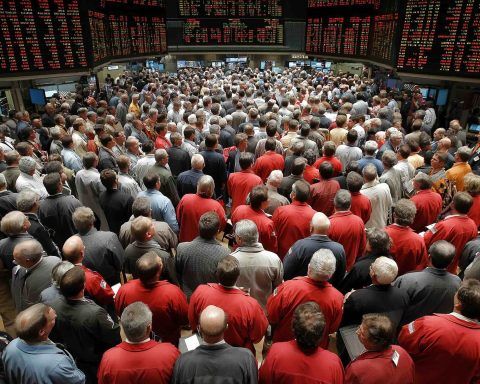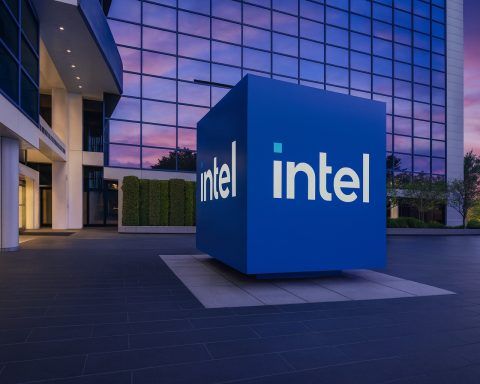As of Sunday, 16 November 2025, Vistra Corp. (NYSE: VST) sits at the heart of the AI‑driven power demand story, with fresh institutional moves, new forecasts and a still‑hot debate over valuation.
Quick snapshot: Vistra today
- Last close (Fri, 14 Nov 2025): $174.69 per share [1]
- Market cap: ~$59.2 billion [2]
- 52‑week range: $90.51 – $219.82 (high set in late September) [3]
- Sector: Utilities – Independent Power Producers, integrated retail + generation business across ~20 U.S. states [4]
Despite pulling back about 22% from its 52‑week high, Vistra stock is still up roughly 35–40% over the past year, reflecting investors’ enthusiasm for its nuclear, gas and clean‑energy portfolio as AI and data‑center growth drive structural power‑demand increases. [5]
What changed for Vistra today (16 November 2025)
Several fresh items dated 16 November 2025 are shaping the narrative around VST:
1. Waratah trims stake, but institutional ownership remains heavy
A new 13F‑based note from MarketBeat reports that Waratah Capital Advisors cut its Vistra position by 32.9% in Q2, selling 31,735 shares and ending the period with 64,655 shares worth about $12.53 million. [6]
That piece also highlights:
- 90.9% institutional ownership in Vistra shares
- A reminder that Q3 EPS of $1.75 came in slightly below one consensus set at $1.78, with revenue of $4.97 billion versus $6.60 billion expected on that dataset [7]
In other words: one hedge fund is taking some profits after a big run, but Vistra remains overwhelmingly institution‑owned.
2. Other 13F updates show buyers stepping in
Also dated 16 November 2025, MarketBeat’s instant alerts flag several other institutional moves:
- Thoroughbred Financial Services LLC disclosed that it bought 8,733 Vistra shares. [8]
- The Commonwealth of Pennsylvania Public School Employees’ Retirement System (PSERS) reported purchasing 35,568 Vistra shares, increasing its stake by about 45.7%. [9]
- PNC Financial Services Group filed an update indicating it has raised its holdings in Vistra, though the exact share count wasn’t visible in publicly indexed excerpts. [10]
Taken together, today’s 13F headlines show a mixed but broadly supportive institutional picture: one notable seller (Waratah) locking in gains, offset by multiple long‑only institutions adding to positions.
3. Fresh forecast hub: Ticker Nerd updates its VST view
Stock‑research site Ticker Nerd updated its Vistra Corp. 2026 forecast page this morning (timestamped “Last updated: November 16, 2025, 10:12 AM UTC”). Key points from its analyst‑consensus digest: [11]
- Current price: $174.69
- Market cap: $59.19 billion
- Analyst ratings (Wall St sample):
- 18 Buy
- 2 Hold
- 1 Sell
- Median 12‑month price target:$238 (range $86 – $288)
- Implied upside: ~36% versus Friday’s close
Ticker Nerd also highlights headline financial metrics over the last year, including revenue down ~20.9% year‑over‑year in the most recent quarter and a net margin of 6.7%, alongside a high debt load (debt‑to‑equity above 3× on one methodology). [12]
4. Vistra shows up in AI‑power‑demand ETF commentary
On Nasdaq.com, a new article syndicated from The Motley Fool — “Is the Vanguard Utilities ETF the Smartest Investment You Can Make Today?” — went live early this morning. It frames utilities as “quiet winners” of the AI data‑center boom and notes that Vistra is a top holding in the Vanguard Utilities ETF (VPU), at about 4.4% of the portfolio. [13]
The piece groups Vistra with NextEra, Southern and Constellation as large U.S. power players positioned to benefit from:
- Rising AI and cloud‑data‑center electricity demand
- Long‑term power‑purchase agreements (PPAs) with “hyperscaler” tech companies
While the article focuses on VPU, the implication is clear: Vistra is now one of the flagship AI‑era utility plays in passive portfolios.
5. Industry interest in Comanche Peak nuclear plant
The USAEE (U.S. Association for Energy Economics) conference agenda lists a tour of Vistra’s Comanche Peak Nuclear Power Plant on 16 November 2025, describing Vistra as “the largest competitive power generator in the U.S.” with a diverse mix of gas, nuclear, solar and storage. [14]
This isn’t a new transaction or contract, but it underscores growing industry and academic interest in Vistra’s nuclear fleet, especially as that fleet becomes more central to supplying 24/7 low‑carbon power for data centers and Texas load growth.
Q3 2025 results: softer net income, stronger EBITDA, tighter guidance
Vistra reported Q3 2025 earnings on 6 November 2025. The official release and accompanying Reuters coverage paint a nuanced picture: [15]
Headline numbers (Q3 2025 vs. Q3 2024):
- GAAP net income: $652 million
- Down from $1.84 billion a year earlier (a drop of ~65%), primarily due to much smaller unrealized mark‑to‑market gains on derivatives and the impact of an outage at the Martin Lake Unit 1 coal plant.
- Ongoing Operations Adjusted EBITDA: $1.581 billion
- Up from $1.438 billion (+~10%), driven by higher realized energy & capacity prices and recognition of nuclear production tax credit (PTC) revenue, partially offset by the outage.
- Revenue: around $4.97 billion, down ~21% year over year and below certain analyst estimates around $6.1–6.6 billion, depending on source. [16]
Different data providers disagree on whether EPS “beat” or “missed” consensus (some models had lower EPS estimates, others higher), but most agree on the same facts:
- EPS was $1.75
- Revenue was light, and
- Underlying EBITDA performance was solid given the volatility in commodity marks.
Guidance: 2025 narrowed, 2026 and 2027 path laid out
In the same release, Vistra: [17]
- Narrowed 2025 guidance for “Ongoing Operations Adjusted EBITDA” to $5.7–$5.9 billion
- Tightened 2025 “Adjusted Free Cash Flow before Growth” (FCFbG) guidance to $3.3–$3.5 billion
- Initiated 2026 guidance:
- EBITDA: $6.8–$7.6 billion
- FCFbG: $3.925–$4.725 billion
- Shared a 2027 “midpoint opportunity” of $7.4–$7.8 billion in EBITDA, based on current power curves and hedging assumptions
Reuters summarized this as Vistra forecasting 2026 adjusted core profit above 2025 levels, reflecting confidence in growing power demand and the expansion of both its gas‑fired and clean‑energy capacity. [18]
The company also noted that, as of 31 October 2025, it had hedged roughly:
- 98% of expected 2025 generation,
- 96% of 2026, and
- ~70% of 2027,
giving management more visibility into forward cash flows even as spot markets remain volatile. [19]
Growth pillars: nuclear, gas and clean energy
Q3 and recent months have been unusually busy on the strategic front:
1. Seven new gas plants and more Permian capacity
Vistra has completed the acquisition of seven natural‑gas plants from Lotus Infrastructure Partners, adding roughly 2,600 MW of capacity across PJM, New England, New York and California. [20]
On top of that, the company announced plans to:
- Build two new gas‑fired units totaling 860 MW in West Texas’ Permian Basin, explicitly aimed at supporting surging regional power demand as oil & gas operations electrify and as data centers grow. [21]
These steps deepen Vistra’s presence in markets where firm capacity is increasingly scarce and capacity prices are rising.
2. Comanche Peak nuclear PPA and the nuclear PTC tailwind
Vistra’s Comanche Peak Nuclear Power Plant in Texas has become a focal asset:
- The company signed a 20‑year power purchase agreement (PPA) for 1,200 MW of output from Comanche Peak with an investment‑grade counterparty, effectively underwriting operations “through the middle of this century,” according to Vistra’s Q3 release. [22]
- Through its Vistra Vision platform — formed by the $6.8 billion acquisition of Energy Harbor — Vistra now controls about 6,400 MW of nuclear capacity, creating the second‑largest competitive, non‑regulated nuclear fleet in the U.S., per RBC Capital Markets. [23]
Critically, this nuclear fleet is eligible for the Inflation Reduction Act’s nuclear production tax credit (PTC):
- The PTC can be worth up to roughly $15/MWh, phasing down as power prices rise above certain thresholds.
- Vistra’s investor materials emphasize that the PTC effectively provides a revenue “floor” for nuclear generation, giving downside protection when power prices are weak. [24]
For investors, that means nuclear is not just a carbon‑free asset class but also a policy‑backed cash‑flow stabilizer.
3. Solar and storage backed by tech giants
Vistra is also accelerating its zero‑carbon portfolio:
- Q3 updates cited progress on Newton Solar & Storage (MISO) and Deer Creek Solar & Storage (CAISO), along with the Oak Hill 200MW solar facility in Texas backed by a PPA with Amazon, and the Pulaski 405MW solar project in Illinois under a PPA with Microsoft. [25]
These projects line up neatly with the AI‑and‑data‑center narrative: hyperscalers need long‑term, low‑carbon power, and Vistra wants to be one of the providers.
Capital returns: dividends and aggressive buybacks
Dividend bump in October
On 30 October 2025, Vistra’s board: [26]
- Declared a quarterly common dividend of $0.227 per share,
- Up about 2% versus its Q4 2024 dividend,
- For an annualized rate of roughly $0.91 per share, equating to a yield of about 0.5% at current prices.
The board also declared semi‑annual dividends on its Series B (7.0%) and Series C (8.875%) preferred shares.
Giant share‑repurchase program
Since November 2021, Vistra has leaned heavily on buybacks:
- As of 31 October 2025, it had executed roughly $5.6 billion of repurchases,
- Reducing shares outstanding by about 30% to ~339 million shares,
- And the board has authorized another $1.0 billion, with around $2.2 billion of total authorization still available through year‑end 2027. [27]
For existing shareholders, that combination of shrinking share count + rising EBITDA guidance is a key part of the long‑term bull thesis.
Valuation and Wall Street views: bullish consensus, pockets of caution
Street consensus: Buy with ~35% upside
Recent research round‑ups show a broadly bullish analyst stance:
- MarketBeat’s 14 November note cites 18 analysts covering Vistra, with a consensus rating of “Buy” (12 Buy, 4 Strong Buy, 2 Hold) and an average 12‑month price target of about $234.21. [28]
- Ticker Nerd’s 16 November aggregation, based on 17 Wall Street analysts, shows a median target of $238, implying roughly 36% upside from $174.69. [29]
- Other sources (StockAnalysis, StockAnalysis‑style aggregators) also frame Vistra as a Buy‑rated large‑cap utility with double‑digit upside potential. [30]
Bearish counterpoint: Trefis sees downside to $126
Not everyone is convinced. A 12 November 2025 Trefis note titled “Vistra Stock To $126?” argues that:
- Valuation looks “High” relative to the S&P 500, with
- P/E ~52.7,
- P/S ~3.5, and
- Price‑to‑free‑cash‑flow ~36.9,
- Revenue growth is inconsistent, with a ~20.9% year‑over‑year decline in the most recent quarter,
- Profitability and financial stability are rated “Moderate,” and
- Downturn resilience is described as “Weak,” given how sharply VST has sold off during past shocks. [31]
Trefis labels the stock “Unattractive” at current levels and suggests $126 as a plausible downside target if sentiment or fundamentals deteriorate.
Balance sheet and risk profile
Vistra is not a low‑debt, sleepy utility.
- Q2 2025 investor materials show total debt around $17.9 billion and net debt around $17.5 billion, with a long‑term net‑leverage target below 3× EBITDA. [32]
- Ticker Nerd and Trefis both flag leverage and relatively low cash as reasons to keep an eye on financial risk metrics. [33]
Operational and policy risks are also non‑trivial:
- In January 2025, a fire at Vistra’s 3,000‑MW Moss Landing battery storage facility in California prompted local evacuations, though no injuries were reported. A Reuters report noted that a water‑based mitigation system “did not work as designed,” and Vistra said it would thoroughly investigate the cause and system design. [34]
- A recent bearish note (noted in some financial media) warned that changes to the nuclear PTC in the Inflation Reduction Act could hit Vistra’s cash flows, though so far major banks like RBC instead emphasize the current PTC as a structural tailwind for Vistra Vision’s ~6.4 GW nuclear fleet. [35]
Add in:
- Interest‑rate risk (refinancing a large debt stack if rates stay higher for longer),
- Commodity and power‑price volatility (partially hedged but never fully tamed), and
- Regulatory and community pushback in some markets (for example, local opposition to battery projects and redevelopment of legacy coal plant sites),
and Vistra clearly isn’t a risk‑free “bond proxy” type utility.
Insider selling and sentiment
Several recent notes highlight insider selling:
- MarketBeat’s consensus‑rating piece notes that CEO James A. Burke sold 43,074 shares (~$9.0 million) in a September transaction and that insiders collectively sold 745,845 shares (~$152 million) over the past 90 days, leaving insiders with about 1.42% ownership. [36]
- Separate filings summarized by Investing.com show Burke selling additional shares in October in conjunction with stock‑option exercises, though those transactions were partly to cover taxes and the cost of the options. [37]
Insider selling in a stock that has run hard does not automatically signal trouble, but it does add another data point for investors weighing valuation and timing.
How might investors interpret today’s Vistra picture?
For readers following VST for Google News / Discover purposes, here’s a balanced framing as of 16 November 2025:
Bullish angles
- Structural demand tailwinds: AI, data centers and electrification are expected to drive U.S. peak power demand growth well above historical averages, and Vistra is positioning itself as a key supplier with nuclear, gas and renewables. [38]
- Nuclear PTC + Comanche Peak PPA: Policy support and long‑dated PPAs add visibility and downside protection to a large portion of future cash flows. [39]
- Scale and diversification: One of the largest competitive generators, spanning Texas, PJM, MISO, CAISO and more, with ~5 million retail customers and a mix of thermal and zero‑carbon assets. [40]
- Capital returns: A growing dividend and a massive buyback program that has already retired about 30% of the share count and still has billions authorized through 2027. [41]
- Analyst consensus: Most covering analysts still rate the stock Buy/Strong Buy, with average price targets ~35% above current levels. [42]
Bearish or cautious angles
- Valuation stretch: On several metrics, Vistra trades at a premium to the broader market and to many utilities, and some research (Trefis) explicitly labels it “Unattractive” at today’s price with potential downside toward $126. [43]
- Earnings volatility: Reported net income is sensitive to derivative marks and power prices; Q3 2025 saw a 65% net‑income drop year‑over‑year, even as EBITDA improved. [44]
- High leverage: Nearly $18 billion of debt plus a capital‑intensive growth plan make Vistra dependent on capital markets and on maintaining strong cash generation. [45]
- Operational and ESG risk: The Moss Landing battery fire and local pushback in some communities illustrate that big‑scale energy infrastructure can face safety, environmental and social challenges. [46]
- Insider selling: Recent sizable disposals by the CEO and other insiders may be purely financial planning — but they do slightly complicate the bullish narrative. [47]
Bottom line
As of 16 November 2025, Vistra Corp. sits at the crossroads of AI‑driven power demand, nuclear policy tailwinds and energy‑transition complexity:
- Today’s news flow is dominated by institutional‑ownership reshuffling, with one large hedge fund trimming exposure while several other investors increase stakes.
- The fundamental story remains anchored in Q3 results, raised long‑term guidance, new gas and nuclear deals, and a large buyback program.
- The key debate for investors is whether current prices already discount those tailwinds, or whether consensus targets ~35% above today’s levels are still realistic given leverage, valuation and execution risk.
This article is for informational purposes only and does not constitute financial or investment advice. Anyone considering VST should review the company’s full filings, risk factors and their own financial situation before making decisions.
References
1. investor.vistracorp.com, 2. companiesmarketcap.com, 3. www.marketwatch.com, 4. investor.vistracorp.com, 5. www.investors.com, 6. www.marketbeat.com, 7. www.marketbeat.com, 8. www.marketbeat.com, 9. www.marketbeat.com, 10. www.marketbeat.com, 11. tickernerd.com, 12. tickernerd.com, 13. www.nasdaq.com, 14. www.usaee.org, 15. investor.vistracorp.com, 16. www.investors.com, 17. investor.vistracorp.com, 18. www.reuters.com, 19. investor.vistracorp.com, 20. investor.vistracorp.com, 21. investor.vistracorp.com, 22. investor.vistracorp.com, 23. www.rbccm.com, 24. filecache.investorroom.com, 25. investor.vistracorp.com, 26. investor.vistracorp.com, 27. investor.vistracorp.com, 28. www.marketbeat.com, 29. tickernerd.com, 30. stockanalysis.com, 31. www.trefis.com, 32. filecache.investorroom.com, 33. tickernerd.com, 34. www.reuters.com, 35. www.rbccm.com, 36. www.marketbeat.com, 37. www.investing.com, 38. www.reuters.com, 39. investor.vistracorp.com, 40. www.rbccm.com, 41. investor.vistracorp.com, 42. www.marketbeat.com, 43. www.trefis.com, 44. investor.vistracorp.com, 45. filecache.investorroom.com, 46. www.reuters.com, 47. www.marketbeat.com








